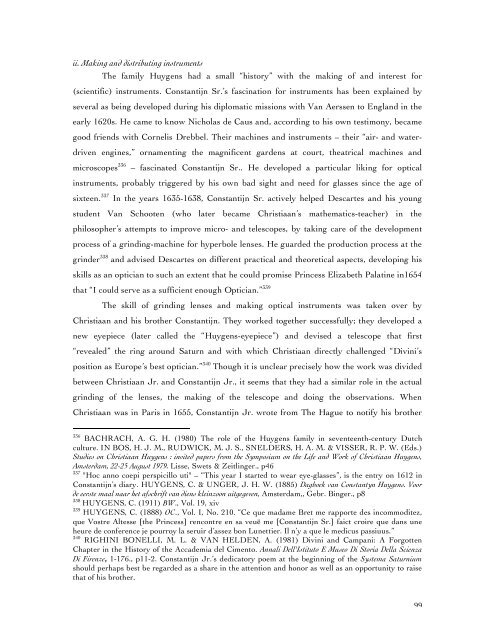Christiaan Huygens – A family affair - Proeven van Vroeger
Christiaan Huygens – A family affair - Proeven van Vroeger
Christiaan Huygens – A family affair - Proeven van Vroeger
Create successful ePaper yourself
Turn your PDF publications into a flip-book with our unique Google optimized e-Paper software.
ii. Making and distributing instruments<br />
The <strong>family</strong> <strong>Huygens</strong> had a small “history” with the making of and interest for<br />
(scientific) instruments. Constantijn Sr.’s fascination for instruments has been explained by<br />
several as being developed during his diplomatic missions with Van Aerssen to England in the<br />
early 1620s. He came to know Nicholas de Caus and, according to his own testimony, became<br />
good friends with Cornelis Drebbel. Their machines and instruments <strong>–</strong> their “air- and water-<br />
driven engines,” ornamenting the magnificent gardens at court, theatrical machines and<br />
microscopes 336 <strong>–</strong> fascinated Constantijn Sr.. He developed a particular liking for optical<br />
instruments, probably triggered by his own bad sight and need for glasses since the age of<br />
sixteen. 337 In the years 1635-1638, Constantijn Sr. actively helped Descartes and his young<br />
student Van Schooten (who later became <strong>Christiaan</strong>’s mathematics-teacher) in the<br />
philosopher’s attempts to improve micro- and telescopes, by taking care of the development<br />
process of a grinding-machine for hyperbole lenses. He guarded the production process at the<br />
grinder 338 and advised Descartes on different practical and theoretical aspects, developing his<br />
skills as an optician to such an extent that he could promise Princess Elizabeth Palatine in1654<br />
that “I could serve as a sufficient enough Optician.” 339<br />
The skill of grinding lenses and making optical instruments was taken over by<br />
<strong>Christiaan</strong> and his brother Constantijn. They worked together successfully; they developed a<br />
new eyepiece (later called the “<strong>Huygens</strong>-eyepiece”) and devised a telescope that first<br />
“revealed” the ring around Saturn and with which <strong>Christiaan</strong> directly challenged “Divini’s<br />
position as Europe’s best optician.” 340 Though it is unclear precisely how the work was divided<br />
between <strong>Christiaan</strong> Jr. and Constantijn Jr., it seems that they had a similar role in the actual<br />
grinding of the lenses, the making of the telescope and doing the observations. When<br />
<strong>Christiaan</strong> was in Paris in 1655, Constantijn Jr. wrote from The Hague to notify his brother<br />
336 BACHRACH, A. G. H. (1980) The role of the <strong>Huygens</strong> <strong>family</strong> in seventeenth-century Dutch<br />
culture. IN BOS, H. J. M., RUDWICK, M. J. S., SNELDERS, H. A. M. & VISSER, R. P. W. (Eds.)<br />
Studies on <strong>Christiaan</strong> <strong>Huygens</strong> : invited papers from the Symposium on the Life and Work of <strong>Christiaan</strong> <strong>Huygens</strong>,<br />
Amsterdam, 22-25 August 1979. Lisse, Swets & Zeitlinger., p46<br />
337 "Hoc anno coepi perspicillo uti" <strong>–</strong> “This year I started to wear eye-glasses”, is the entry on 1612 in<br />
Constantijn’s diary. HUYGENS, C. & UNGER, J. H. W. (1885) Dagboek <strong>van</strong> Constantyn <strong>Huygens</strong>. Voor<br />
de eerste maal naar het afschrift <strong>van</strong> diens kleinzoon uitgegeven, Amsterdam,, Gebr. Binger., p8<br />
338 HUYGENS, C. (1911) BW., Vol. 19, xiv<br />
339 HUYGENS, C. (1888) OC., Vol. I, No. 210. “Ce que madame Bret me rapporte des incommoditez,<br />
que Vostre Altesse [the Princess] rencontre en sa veuë me [Constantijn Sr.] faict croire que dans une<br />
heure de conference je pourroy la seruir d’assez bon Lunettier. Il n’y a que le medicus passiuus.”<br />
340 RIGHINI BONELLI, M. L. & VAN HELDEN, A. (1981) Divini and Campani: A Forgotten<br />
Chapter in the History of the Accademia del Cimento. Annali Dell'Istituto E Museo Di Storia Della Scienza<br />
Di Firenze, 1-176., p11-2. Constantijn Jr.’s dedicatory poem at the beginning of the Systema Saturnium<br />
should perhaps best be regarded as a share in the attention and honor as well as an opportunity to raise<br />
that of his brother.<br />
99


